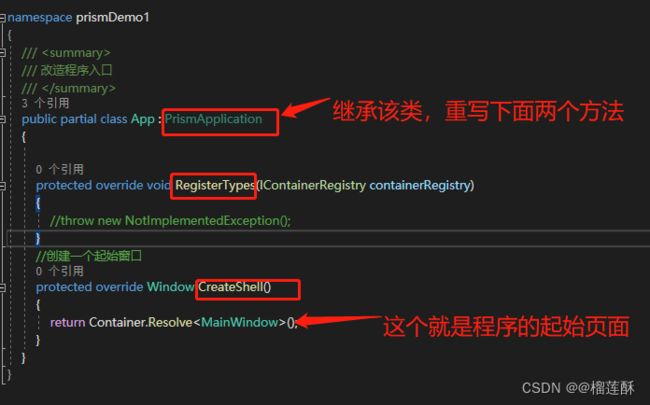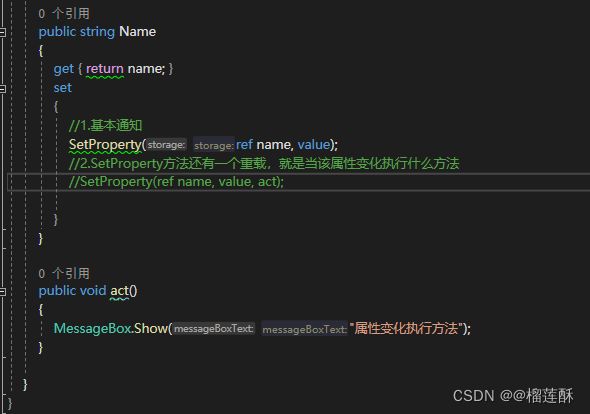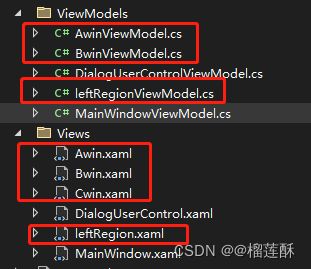wpf prism使用
目录
1.Nuget中安装prism框架:
2.改造程序启动入口
3.View和ViewModel自动关联
4.绑定
5.Command
6.Event Aggregator(事件聚合器)、消息通知
7.弹窗、对话服务 DialogService
8.Region区域
10.module 模块
1.Nuget中安装prism框架:
Prism.Unity(IOC容器) 其中的prism.wpf和prism.core会自动添加过来
2.改造程序启动入口
app.xaml中按照截图改造:
app.xaml 点击F7查看代码,具体代码如下图。其中CreateShell()就是程序的入口
3.View和ViewModel自动关联
规则: ① View文件必须放在Views文件夹下,ViewModel文件必须放在ViewModels文件夹下且文件命名开头要和view文件相同,结尾则是以ViewModel结尾。如下图:
② xaml中添加
xmlns:prism="http://prismlibrary.com/"
prism:ViewModelLocator.AutoWireViewModel="True"
如下图
4.绑定
继承BindableBase,该类实现了通知属性
如下图:同时SetProperty有2个重载方法,第二种可以当该属性变化执行什么方法
5.Command
常规有参和无参方法
public DelegateCommand noparmCommadn { get; private set; }//无参方法
public DelegateCommand haveparmCommadn { get; private set; }//有参方法
public MainWindowViewModel()
{
noparmCommadn = new DelegateCommand(noparm);
haveparmCommadn = new DelegateCommand(haveparm);
}
private void haveparm(string obj)
{
MessageBox.Show($"我是有参方法,参数是{obj}");
}
private void noparm()
{
MessageBox.Show("我是无参方法");
} 检查是否可执行
① 调用RaiseCanExecuteChanged的调用更新CanExecute;
public MainWindowViewModel()
{
SaveCommand = new DelegateCommand(DoSave, CanExecute);
}
public DelegateCommand SaveCommand {get;}
private void DoSave()
{
//执行逻辑
}
private bool CanExecute()
{
//能否执行的逻辑
return Age < 200;
}
private int _age= 100;
public int Age
{
get{ return _age;}
set
{
SetProperty(ref _age, value);
SaveCommand.RaiseCanExecuteChanged();
}
}② ObservesProperty:
ObservesProperty是指监听一个属性的变化,当发生变化时,进行状态检查;支持多条件;
public MainWindowViewModel()
{
SaveCommand = new DelegateCommand(DoSave, CanExecute)
.ObservesProperty(()=>Name)
.ObservesProperty(()=>Age);
}
public DelegateCommand SaveCommand {get;}
private void DoSave()
{
//执行逻辑
}
private bool CanExecute()
{
//能否执行的逻辑
return Age < 200 && Name!=string.Empty;
}
private int _age;
public int Age
{
get { return _age; }
set { SetProperty(ref _age, value); }
}
private int _name;
public int Name
{
get { return _name; }
set { SetProperty(ref _name, value); }
}③ObservesCanExecute 它监听一个属性值,当其为true可用,false不可用
public DelegateCommand SaveCommand2 { get; }
public MainWindowViewModel()
{
SaveCommand2 = new DelegateCommand(DoSave2).ObservesCanExecute(()=>IsEnable);
}
private bool isEnable;
public bool IsEnable
{
get { return isEnable; }
set { isEnable = value; }
}6.Event Aggregator(事件聚合器)、消息通知
Prism 提供了一种机制,可以实现应用程序中松散耦合组件之间的通信。这种机制基于事件聚合器服务,允许发布者和订阅者通过事件进行通信,并且彼此之间仍然没有直接引用。
事件聚合器提供多播发布/订阅功能。这意味着可以有多个发布者引发相同的事件,并且可以有多个订阅者监听相同的事件。当然订阅者也可以过滤消息,只收到自己需要的。
通过事件聚合器服务可以使用IEventAggregator接口获取到事件聚合器。事件聚合器负责定位或构建事件,并在系统中保存事件的集合。首次访问一个事件时,如果该事件尚未构建,则构建
经典图如下:
用途:一般用在VM之间的消息交互,VM调用View中的方法等其他无法直接实例化调用方法类的情况
1.创建事件(无参),继承PubSubEvent即可
public class MessageEventNoParm:PubSubEvent
{
}有参,继承PubSubEvent
public class MessageEventHaveParm :PubSubEvent
{
} 订阅:
public partial class MainWindow : Window
{
public MainWindow(IEventAggregator aggregator)
{
InitializeComponent();
aggregator.GetEvent().Subscribe(ShowMethod, arg => arg == "key");//有参订阅,同时加过滤
aggregator.GetEvent().Subscribe(ShowMethodNoParm);//无参
}
private void ShowMethodNoParm()
{
//throw new NotImplementedException();
MessageBox.Show("ShowMethodNoParm");
}
private void ShowMethod(string obj)
{
MessageBox.Show("ShowMethodHaveParm : "+obj);
}
} 关于Subscribe函数,有几个重载,其中参数最多的有4个:
action: 发布事件时执行的委托。
ThreadOption枚举: 指定在哪个线程上接收委托回
KeepSubscriberReferenceAlive: 如果为true,则Prism.Events.PubSubEvent保留对订阅者的引用因此它不会收集垃圾。
filter: 进行筛选以评估订阅者是否应接收事件。是一个Predicate委托,结果为true时才接收。
发布:
public DelegateCommand MessageEventNoParmCommad { get; private set; }
public DelegateCommand MessageEventHaveParmCommad { get; private set; }
private readonly IEventAggregator _aggregator;//事件聚合器
public MainWindowViewModel(IEventAggregator aggregator)
{
_aggregator=aggregator;
MessageEventNoParmCommad = new DelegateCommand(noparmME);
MessageEventHaveParmCommad = new DelegateCommand(haveparmME);
}
private void haveparmME(string obj)
{
_aggregator.GetEvent().Publish(obj);//有参发布
}
private void noparmME()
{
_aggregator.GetEvent().Publish();//无参发布
} 该节参考:Prism事件聚合器(Event/发布订阅) - 傲慢与偏见luc - 博客园 (cnblogs.com)
7.弹窗、对话服务 DialogService
Prism提供了一组对话服务, 封装了常用的对话框组件的功能, 例如:
- RegisterDialog/IDialogService (注册对话及使用对话)
- 打开对话框传递参数/关闭对话框返回参数
- 回调通知对话结果
①新建用户控件 UserControl ,比如叫DialogUserControl
②创建ViewModel,对应起名叫DialogUserControlViewModel。然后继承IDialogAware
IDialogAware中方法说明:
- CanCloseDialog()函数是决定窗体是否关闭
- OnDialogClosed()函数是窗体关闭时触发,触发条件取决于CanCloseDialog()函数
- OnDialogOpened()函数时窗体打开时触发,比窗体Loaded事件早触发
- Title为窗体的标题
- RequestClose为关闭事件,可由此控制窗体的关闭
using Prism.Commands;
using Prism.Mvvm;
using Prism.Services.Dialogs;
using System;
using System.Collections.Generic;
using System.Linq;
using System.Text;
using System.Threading.Tasks;
namespace prismDemo1.ViewModels
{
//弹窗对话在使用对话时则继承IDialogAware
public class DialogUserControlViewModel : IDialogAware
{
//窗体的标题
public string Title { get; set; }
private string message;
public string Message
{
get { return message; }
set { message = value; }
}
///
/// 关闭事件,可由此控制窗体的关闭
///
public event Action RequestClose;
///
/// 决定窗体是否关闭
///
///
/// 窗体关闭时触发,触发条件取决于CanCloseDialog()函数
///
///
/// 窗体打开时触发,比窗体Loaded事件早触发
/// 一般用来接受参数
///
///
/// ("message");
Title = parameters.GetValue("Title");
}
public DelegateCommand btnCliclCommand { get; private set; }
public DialogUserControlViewModel()
{
btnCliclCommand = new DelegateCommand(btnClick);
}
private void btnClick()
{
IDialogParameters parameters = new DialogParameters();
parameters.Add("param1", "Hello Baby");
RequestClose?.Invoke(new DialogResult(ButtonResult.OK, parameters));
}
}
}
③ 在App.cs中注册对话服务
containerRegistry.RegisterDialog();//注册弹窗 ④IdialogService接口说明
public interface IDialogService
{
void Show(string name, IDialogParameters parameters, Action callback);
void Show(string name, IDialogParameters parameters, Action callback, string windowName);
void ShowDialog(string name, IDialogParameters parameters, Action callback);
void ShowDialog(string name, IDialogParameters parameters, Action callback, string windowName);
}
//
// 摘要:
// Extensions for the IDialogService
public static class IDialogServiceExtensions
{
public static void Show(this IDialogService dialogService, string name);
public static void Show(this IDialogService dialogService, string name, Action callback);
public static void ShowDialog(this IDialogService dialogService, string name);
public static void ShowDialog(this IDialogService dialogService, string name, Action callback);
}
接口的实现中,最多有四个参数:
- name:指的是Dialog的name,由注册的时候指定,没有指定的时候默认为View类的类名
- parameters:传递给对话框的参数
- callback:对话框被关闭时的回调函数
- windowName:注册对话框的父窗体名
⑤ 使用弹出对话:
private readonly IDialogService _dialogService;//弹窗服务
public MainWindowViewModel(IEventAggregator aggregator, IDialogService dialogService)
{
_dialogService = dialogService;
openDialogCommand = new DelegateCommand(openDiaglog);//打开弹窗
}
private void openDiaglog()
{
DialogParameters dialogParameters = new DialogParameters
{
{"Title","我是弹窗"},
{"message","我是消息"}
} ;
_dialogService.ShowDialog("DialogUserControl", dialogParameters, DialogCallback);
}
private void DialogCallback(IDialogResult result)
{
//对话框关闭之后的回调函数,可以在这解析结果。
ButtonResult result1 = result.Result;
var param = result.Parameters.GetValue("param1");
} 8.Region区域
什么是区域
在Prism当中,一个页面我们可以不再为其固定显示的内容,而这种概念变成了区域(Region)划分的概念。将页面显示的区域划分成N个Region,每一个Region将动态分配区域。它将负责承担我们的UI组件或者控件。
①给页面分区域,如下代码分开leftRegion和mainRegion2个区域,注意如果是单页面切换用ContentControl,多页面用TabControl
②创建4个用户控件并且关联上ViewModel,如图
③在App.cs注册view
protected override void RegisterTypes(IContainerRegistry containerRegistry)
{
//throw new NotImplementedException();
containerRegistry.RegisterDialog();//注册弹窗
//containerRegistry.RegisterDialog("dd");//注册弹窗 dd是给弹窗起名,不写默认为类名
//注册区域
containerRegistry.RegisterForNavigation();
containerRegistry.RegisterForNavigation();
containerRegistry.RegisterForNavigation();
containerRegistry.RegisterForNavigation();
} ④把页面关联到区域
private readonly IRegionManager _regionManager;//区域服务
public MainWindowViewModel(IEventAggregator aggregator, IDialogService dialogService,IRegionManager regionManager)
{
_regionManager = regionManager;
_regionManager.RegisterViewWithRegion("leftRegion", "leftRegion");
//_regionManager.RegisterViewWithRegion("leftRegion", "leftRegion");
}leftRegion页面切换,这里注意用RegisterViewWithRegion来做页面切换有问题,需要用Navigation即可。接下面一章对Navigation进行讲解
9.Navigation导航
① 导航是在区域的基础上进行的。
RequestNavigate最多有4个参数:
第一个参数是RegionName,第二个参数是我们前面注册的ViewName。其实它还有很多重载函数,还有另外两个参数Action navigationCallback,导航完成时的回调和NavigationParameters navigationParameters导航是传参
region.RequestNavigate("ContentRegion", page);
_regionManager.RequestNavigate("mainRegion", obj, NavigationCallback, parameters);
//请求导航完成的回调函数
private void NavigationCallback(NavigationResult result)
{
MessageBox.Show(result.Context.Uri +" :"+ result.Error?.Message+" :"+ result.Result);
journal=result.Context.NavigationService.Journal;//添加到导航日志
}② 导航页面切换的接口INavigationAware
public class AwinViewModel : INavigationAware
{
//IConfirmNavigationRequest 该类也是继承INavigationAware 允许用户针对导航请求进行拦截。同时也需要多实现一个方法ConfirmNavigationRequest
//是否创建新示例。为true的时候表示不创建新示例,页面还是之前的;如果为false,则创建新的页面
public bool IsNavigationTarget(NavigationContext navigationContext)
{
//throw new NotImplementedException();
return true;
}
//导航离开当前页面前。
public void OnNavigatedFrom(NavigationContext navigationContext)
{
//throw new NotImplementedException();
}
//导航到当前页面前, 此处可以传递过来的参数以及是否允许导航等动作的控制
public void OnNavigatedTo(NavigationContext navigationContext)
{
var vale = navigationContext.Parameters["key"];
}
}③ IConfirmNavigationRequest接口,该类也是继承INavigationAware 允许用户针对导航请求进行拦
public void ConfirmNavigationRequest(NavigationContext navigationContext, Action continuationCallback)
{
bool result = true;
if (MessageBox.Show("Do you to navigate?", "Navigate?", MessageBoxButton.YesNo) == MessageBoxResult.No)
result = false;
//true则同意 false则拒绝
continuationCallback(result);
}
④ IRegionNavigationJournal导航日志接口
导航日志,其实就是对导航系统的一个管理功能,理论上来说,我们应该知道我们上一步导航的位置、以及下一步导航的位置,包括我们导航的历史记录。以便于我们使用导航对应用程序可以灵活的控制。
IRegionNavigationJournal接口有如下功能:
GoBack() : 返回上一页
CanGoBack : 是否可以返回上一页
GoForward(): 返回后一页
CanGoForward : 是否可以返回后一页
public class leftRegionViewModel
{
public DelegateCommand openWindowCommand { get; }
private readonly IRegionManager _regionManager;
private IRegionNavigationJournal journal;//导航日志
public DelegateCommand backCommand { get; }//上一页
public DelegateCommand forwardCommand { get; }//下一页
public leftRegionViewModel(IRegionManager regionManager)
{
openWindowCommand = new DelegateCommand(openwin);
backCommand = new DelegateCommand(back);
forwardCommand = new DelegateCommand(forward);
_regionManager = regionManager;
}
private void forward()
{
if (journal.CanGoForward)
{
journal.GoForward();
}
}
private void back()
{
if (journal.CanGoBack)
{
journal.GoBack();
}
}
private void openwin(string obj)
{
//用这种方法在页面切换时有问题,它只显示第一个页面
//_regionManager.RegisterViewWithRegion("mainRegion", obj);
//需要用Navigation即可
//_regionManager.RequestNavigate("mainRegion", obj);
//其他重载
//传参
NavigationParameters parameters=new NavigationParameters();
parameters.Add("key", "value");
_regionManager.RequestNavigate("mainRegion", obj, NavigationCallback, parameters);
}
//请求导航完成的回调函数
private void NavigationCallback(NavigationResult result)
{
MessageBox.Show(result.Context.Uri +" :"+ result.Error?.Message+" :"+ result.Result);
journal=result.Context.NavigationService.Journal;//添加到导航日志
}
} 10.module 模块
①首先窗体模块A和模块C 这里我使用prism在VS中的插件直接创建,安装路径 扩展-->管理扩展->搜索prism 如下图:
②在模块A中注册,同理模块C也是
namespace prismModuleA
{
public class prismModuleAModule : IModule
{
public void OnInitialized(IContainerProvider containerProvider)
{
}
public void RegisterTypes(IContainerRegistry containerRegistry)
{
containerRegistry.RegisterForNavigation();
}
}
} ③ 在主程序中重写ConfigureModuleCatalog方法
protected override void ConfigureModuleCatalog(IModuleCatalog moduleCatalog)
{
//加入模块后这时候我就能在需要打开该窗体的地方使用 regionManager.RegisterViewWithRegion("mainRegion", 模块名);
moduleCatalog.AddModule();
moduleCatalog.AddModule();
base.ConfigureModuleCatalog(moduleCatalog);
} ④ 在需要打开模块中页面地方可使用
egionManager.RegisterViewWithRegion("mainRegion", 模块名中的页面名);
参考:Prism入门之模块(Module) - 傲慢与偏见luc - 博客园 (cnblogs.com)







